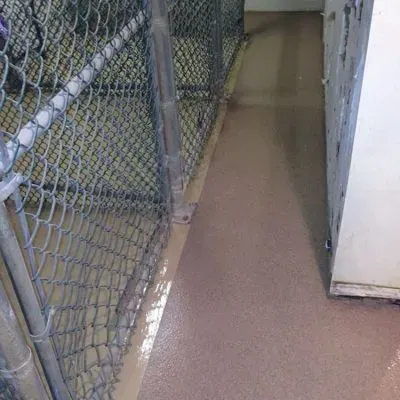Animal Care Epoxy Flooring
Animal care operations include a wide range of uses, including non-profit shelters, pet shops, kennels and multi-animal home locations and even agricultural use. While many of the needs are the same as veterinary clinics, there are difference in terms of the time animals will spend in one location as well as the needs for maintenance.


Issues Affecting Potential Coating
Benefits of Epoxy Coating for Animal Care Facilities
Facilities that have only a bare concrete slab floor have many issues.
Absorbency – concrete slabs are absorbent. Their nature allows everything from water to impurities – as well as stains – from things spilled on them to be absorbed into the slab. Any number of items from animal food to waste products – vomit, urine and feces – can create an environment for bacteria to penetrate and grow.
In some case this causes issues like odors as well as being the cause of transmission of disease or viruses that can cause huge issues for your facility. Harmful and highly unpleasant odors may result from of prior lack of hygiene care.
Additionally, bare slabs may result in slippery floors and danger for animals and their human associates as well.
BENEFITS OF EPOXY COATING FOR ANIMAL CARE FACILITIES
Epoxy floor coating systems provide a variety of benefits:
1. If the existing concrete slab is in good condition, normal installation takes only 3 days, which means only a minimal amount of interference to the regular schedule.
2. Because the surface is non-porous (bare concrete slabs are absorbent), it eliminates many of the negative issues present with untreated concrete or with other coatings that are not resistant to waste, vomit, urine, blood or saliva left by animals.
3. Epoxy’s resiliency and non-porous nature also guards against odor build up and associated disease or viruses resulting from accumulated waste – even in corners!
4. The finished surface is water-resistant – not affected and allowing for quick maintenance
5. Epoxy coating reduces problems with footing, including slips, which means a lower possibility of animals, or humans, being injured.
6. Maintenance is relatively simple: regular non-abrasive brushes or brooms are ideal for use – along with regular rinsing – for routine needs; degreasers and other cleaners can be used –check labels for ingredients that might be harmful – for more thorough work.
Prior Damage
Depending on the location and current as well as prior uses of the facility in which the floor is locate, there may be any number of issues involved with base concrete slab. Environment can have substantial effects on the surface – causing have cracks and seams that need to be addressed before coating.
Rate of Moisture Vapor Transmission
Moisture vapor transmission through the slab can be a major problem. A simple (calcium chloride) test can be administered prior to application in order to determine sufficient tolerances according to the manufacturer’s specifications for a proper coating. If a calcium chloride test demonstrates high vapor transmission, then an epoxy concrete vapor control primer must be used.
Even though it’s rare, a vapor transmission rate reading can be so high that an epoxy concrete vapor control primer may prove insufficient which means that more drastic remedies may be needed or finding a potential floor covering alternative.
